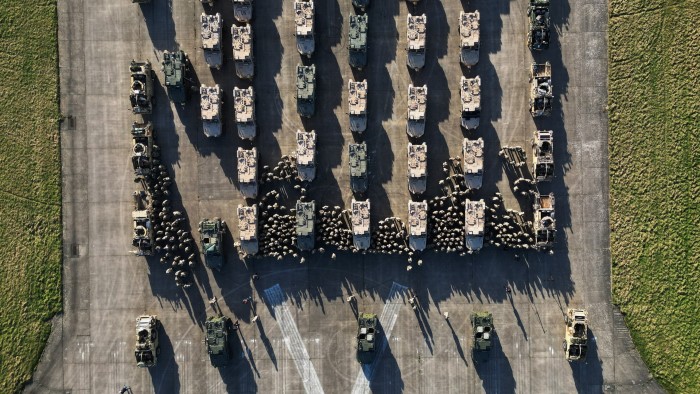Unlock the Editor’s Digest for free
Roula Khalaf, Editor of the FT, selects her favourite stories in this weekly newsletter.
The UK is expected to back Nato’s push for all members to spend at least 3.5 per cent of GDP on defence by 2035, despite Prime Minister Sir Keir Starmer’s hesitation over when the UK will get to 3 per cent.
Following pressure from US President Donald Trump, Nato secretary-general Mark Rutte is pushing all members to agree to a significantly higher target of 3.5 per cent compared with 2 per cent at present. An additional 1.5 per cent would be targeted for areas such as security and defence-related infrastructure, adding up to 5 per cent in total.
Nato defence ministers, including the UK’s John Healey, will meet on Thursday at the alliance’s headquarters in Brussels and are set to give their approval to the new target, officials briefed on the preparations told the Financial Times.
But the timing is potentially awkward for the Labour government as it tries to balance boosting defence spending with tight public finances and a series of unpopular welfare cuts that have hurt its standing in the polls.
Starmer on Monday launched the UK’s long-awaited strategic defence review, billed as one of the biggest overhauls of the UK armed forces in a century, but refused to commit to a specific date for defence spending to rise to 3 per cent.
The prime minister said he was “100 per cent this can be delivered” but still declined to give a precise date.
Backing Nato’s push to increase defence spending further by 2035 will raise fresh questions about where the money will come from. Starmer’s government has said it will raise defence spending to 2.5 per cent of GDP by 2027, up from 2.3 per cent, to be funded by slashing the international aid budget.
A 3 per cent target in the next parliament would raise defence spending above £85bn a year from £64bn in 2024, while 3.5 per cent in 2035 would boost it well above £100bn.
Trump has demanded that all Nato allies commit to raising their defence spending to 5 per cent of GDP over the next decade, a level that US officials say will “equalise” the burden of defending Europe.
Nato diplomats said that agreeing to Trump’s demand was a prerequisite for the US president attending the Nato leaders’ summit in The Hague later this month.
Other leaders hope that by pledging to hit the target, Trump will not repeat his threats to reduce US protection to Nato allies in Europe and reduce American troop and weapon deployments on the continent.
Under a plan drawn up by Rutte, the 5 per cent target will consist of 3.5 per cent on core defence spending and 1.5 per cent on defence-adjacent issues such as cyber security and military mobility infrastructure. Most allies already hit the 1.5 per cent portion, meaning the 3.5 per cent core defence spending is the bigger challenge for members.
“I assume that in The Hague we will agree on a high defence spend target of in total 5 per cent,” Rutte said during a visit to the US last week, echoing previous remarks made by US secretary of state Marco Rubio.
Downing Street declined to comment beyond pointing to Starmer’s comments on Monday that the government was taking a “Nato-first approach”.
Lord George Robertson, a former Nato secretary-general and co-author of the UK’s SDR report, told the Newsagents podcast on Tuesday that Rutte was right “to have a target . . . to have an ambition”, but cautioned about countries actually following through on commitments.
“I can see that it’s going to be hugely difficult for a lot of countries to actually do that,” Robertson said.
Additional reporting by Jim Pickard in London






